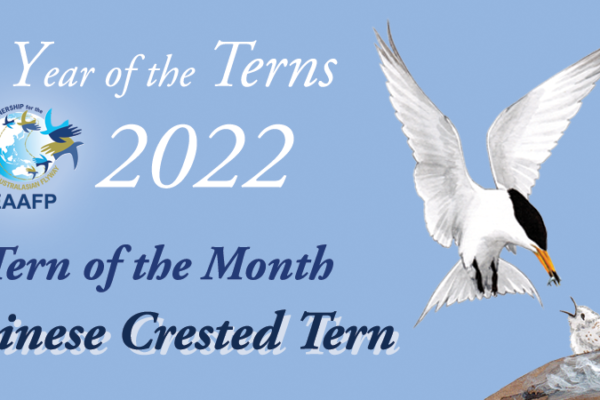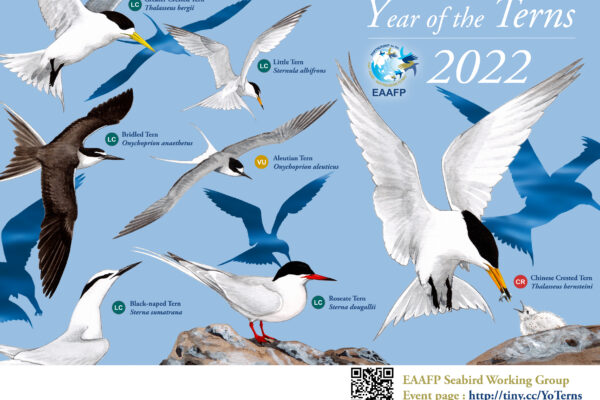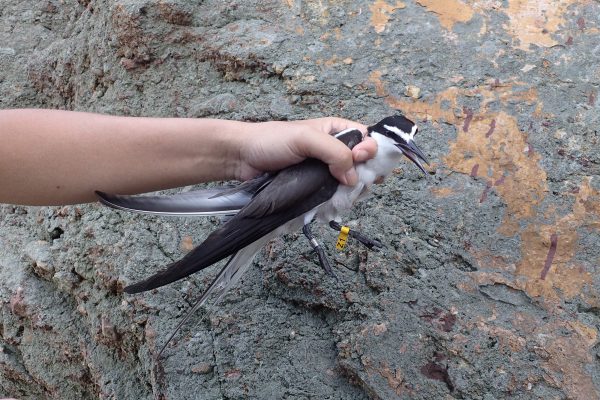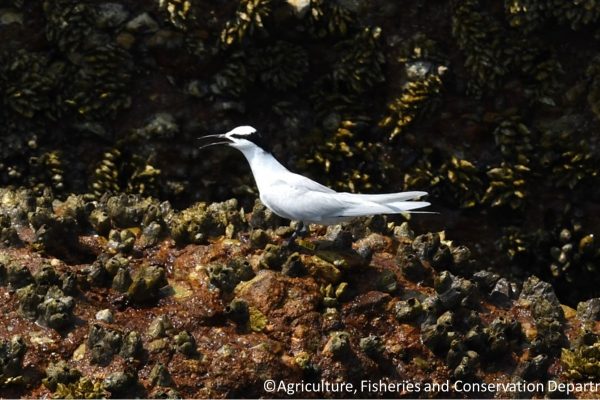-
Chinese Crested Tern
©Simba Chan Common name: Chinese Crested Tern Scientific name: Thalasseus bernsteini Local names: 中华凤头燕鸥 (Simplified Chinese), 中華鳳頭燕鷗/黑嘴端鳳頭燕鷗(Traditional Chinese), 뿔제비갈매기 (Korean), ヒガシシナアジサシ(Japanese), Dara-laut Cina (Indonesian), Camar Cina Berjambul (Malayu), Nhàn mào Trung Quốc (Vietnamese). Conservation status: IUCN - Critically Endangered, CMS - Appendix I The Chinese Crested Tern (Thalasseus bernsteini) is one of the rarest seabirds in the world. It seemed it had always been rare. It was not described until 1861, when the type specimen was collected at Kao, Halmahera, Indonesia. Since the last 21 specimens were collected at Qingdao, China in 1937, there was no confirmed record of the species. In 2000, the bird was resighted on Matsu Islands off the coast of Fujian. In 2004 another breeding colony was discovered at Jiushan Islands in Zhejiang Province. With international cooperation using social attraction restored the breeding colony, Chinese Crested Tern is estimated to be about 150 birds in population and is stable or slowly increasing. Identification Size: around 45 cm; wingspan 94 cm. Head: Short crested, Breeding: entire cap turned black with crest; Non-breeding: forehead turned white Beak: bright orange-yellow bill with a black tip and almost invisible white tip at the end of the beak Light grayish from the mantle to upperwing, rump, uppertail-coverts and tail forked tail; black legs Distribution range Breeding range: Since the rediscovery of the species in 2000, there are only five breeding locations: Jiushan Islands, Wuzhishan Islands (Zhejiang, China), Matsu Islands (Fujian, China), Penghu Islands (Taiwan, China) and Chilsando Islands in the Republic of Korea. Non-breeding range: The bird is believed to breed off Shandong formerly, but is now only sighted in coastal areas in Shandong after breeding season. Non-breeding records were from South China, Japan, the Philippines, Thailand and eastern Malaysia. Confirmed recent wintering grounds include Seram, Maluku of Indonesia and Mindanao of the Philippines. Eastern Indonesia and the Philippines are likely to be the major wintering areas for this species. Habitat Breeding habitat of Chinese Crested Tern, Tiedun Dao, Zhejiang, China © Simba Chan Chinese Crested Tern breeds only on offshore uninhabited islets, non-breeding habitat is of little information. Non-breeding ground in Indonesia © Ken Fung Behavior During the breeding season, Chinese Crested Tern usually congregate with Greater Crested Tern nesting areas, but in Ro Korea they nest in colony of Black-tailed Gulls. They can move between different colonies in the breeding season and are very nervous at disturbance. They are very little known during the non-breeding season but are likely to stay in flocks with Greater Crested Terns. However, these two species may not migrate together as previously assumed. Breeding Chinese and Greater Crested Terns in Tiedun Dao, China © Simba Chan Population estimate About 150 individuals of all ages (prior to 2012, only less than 50 individuals). Main threats Human disturbance (people reaching too close to the breeding colonies) Egg collection Other threats: Pollution (water pollution, plastic pollution) Overfishing Natural threats: Typhoons Natural predators (e.g. Peregrine Falcon, snakes, rats) Conservation Work Social attraction setting to restore Chinese Crested Tern in China © Vivian Fu International collaboration to use social attraction technique to restore breeding population Since 2011, an international cooperation project using social attraction (using decoys and playback) restored the breeding colony at Jiushan. The population increased from less than 50 to about 150 in 10 years. Subsequently, Social attraction was also done in breeding grounds of Matsu, Wuzhishan and Chilsando. Remove human-induced threats Through education and advocacy to promote law enforcement to prevent exploitation (egg collection) and disturbance, such as regulated tourism, allocation of park rangers for monitoring, as well as fishing communities and public engagement. Fun Fact Chinese Crested Tern was once thought extinct, so when it was rediscovered after 63 years in 2000, the bird was called “Bird of Legend”. Prior to 1975, the Chinese Crested Tern was known as Sterna zimmermanni Reichenow 1903 and the type locality was thought to be Qingdao of Shandong Province, China (when the team from Fan Memorial Institute of Biology collected 21 specimens from Qingdao area in 1937 all of them were labeled as Thalasseus zimmermanni). It was later on corrected that the type specimen should be the one collected near Halmahera, Indonesia in 1861, which had been misplaced as a population of Greater Crested Tern. Interestingly, when Dr. Nagamichi Kuroda obtained his specimen of Chinese Crested Tern from Korea in 1917 he also regarded it as a Greater Crested Tern. Luckily he left a detailed description of this long-lost specimen for verification to be a Chinese Crested Tern. Reference IUCN Red List: https://www.iucnredlist.org/species/22694585/131118818 Birds of the World: https://birdsoftheworld.org/bow/species/chcter2/cur/introduction Simba Chan, 2022, Chinese Crested Tern (Thalasseus bernsteini). Editor(s): Dominick A. DellaSala, Michael I. Goldstein, Imperiled: The Encyclopedia of Conservation, Elsevier: Pages 19-28 (link Gochang Big Bird Race 2023 brought birdwatchers to contribute bird data to the UNESCO World Heritage Site Special achievement award to the Chinese Crested Tern team Webinar on Chinese Crested Tern in the Yellow Sea and Seabird Conservation in China Chinese Crested Tern banded in Republic of Korea sighted in China Restoration of the Critically Endangered Chinese Crested Tern using social attraction technique A Conservation Success in Minjiang River Estuary A tern for the better Critically Endangered Chinese Crested Terns appear on a deserted island in South Korea The First Ever Banded Chinese Crested Tern Chick has Fledged EAAFP Seabird Working Group Update
Continue reading -
EAAFP Secretariat and Seabird Working Group launches “Year of the Terns” in 2022
On 22nd February, 2022, the EAAFP Secretariat and EAAFP Seabird Working Group announced 2022 as the “Year of the Terns” for the EAA Flyway. The announcement is a preface to the focus that EAAFP will put on raising awareness and promoting collaboration for the conservation of seabirds in the East Asian-Australasian Flyway (EAA Flyway). The campaign was officially launched during the 49th Annual Meeting of Pacific Seabird Group (PSG) Northeast Asia Seabird Conservation Committee Meeting. There are over 150 seabird species in the EAA Flyway. Many seabird species have long trans-equatorial migration routes and spend most of the year at sea, only returning to land to breed. Since much of their annual lifecycle is spent offshore, they are especially difficult to study and most aspects of their life histories remain poorly understood in the EAA Flyway. While many populations are doing well, others are experiencing population declines that are difficult to detect given the months they remain away from global eyes. To increasing awareness of these Ocean Sentinels, the Secretariat and the EAAFP Seabird Working Group are excited to designate 2022 as the “Year of the Terns”. The Secretariat and the EAAFP Seabird Working Group hope to accomplish the following three objectives with this campaign: 1. To raise awareness of seabirds, especially terns, within EAA Flyway 2. To encourage dialogues and collaboration on seabirds research and conservation within EAA Flyway 3. To promote and strengthen working relationships within EAAFP Seabird Working Group, also with site managers of Flyway Network Sites for seabirds, and beyond To do so, seven, out of the 16 EAA Flyway tern species, were selected for the campaign, including the Chinese Crested Tern (CR), Aleutian Tern (VU), Greater Crested Tern, Bridled Tern, Little Tern, Black-naped Tern and Roseate Tern. The Secretariat and Seabird WG will also be developing activities for the campaign accordingly. Robb Kaler, Chair of EAAFP Seabird Working Group, expressed “According to a global assessment, seabirds are generally more threatened than other comparable groups of birds. Many populations have declined rapidly in recent decades due to various threats, including incidental bycatch, overfishing, pollution, invasive species, warming oceans and more. We hope that the “Year of the Terns” campaign, will raise awareness about seabirds, both for the health of their populations, and as an indicator of the health of oceans on which seabirds and all of us depend. We are excited for this opportunity for more joint actions to conserve seabirds in the EAA Flyway and expand the Seabird Working Group’s network of partners.” Doug Watkins, Chief Executive of EAAFP Secretariat said. “Seabirds received relatively less attention and conservation effort in the EAA Flyway compared to other taxa, probably due to the vast distribution range of many species and the challenges to study them. Therefore, we need to strengthen our network in seabird studies and conservation and promote more collaboration in the region, and the actions cannot be delayed.” Stay tuned for more upcoming activities such as a photo competition and a talk series. The EAAFP Secretariat and Seabird Working Group invite everyone to support and celebrate the “Year of the Terns with them! Check the “Year of the Terns” webpage: https://www.eaaflyway.net/year-of-the-terns-2022/ For inquiries and interest to support the Year of the Terns, please contact: Ms. Vivian Fu Communication Officer, EAAFP Secretariat Email: communication@eaaflyway.net
Continue reading -
Conservation Research of breeding terns in Hong Kong
The Hong Kong Bird Watching Society (HKBWS) has started a conservation research on breeding terns in Hong Kong waters. In summer 2019, a total of 110 adult and juvenile…
Continue reading -
Color flagging of Breeding Terns in Hong Kong (2018)
Following the color flagging of Bridled Terns (Onychoprion anaethetus) in 2017 (https://eaaflyway.net/bridled-terns-onychoprion-anaethetus-ringed-in-hong-kong/), the Agriculture, Fisheries and Conservation Department (AFCD) of the Hong Kong Government continued the flagging of…
Continue reading
- 1
- 2





